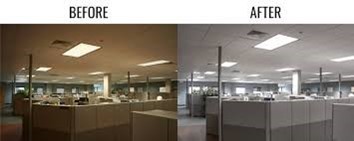Energy Efficiency Projects
The Office of Energy and Sustainability utilizes a systemic data driven process, based on industry standard best practices and energy data, to identify and implement cost-effective energy-efficiency projects. These projects, when implemented, strive to attain a less than 5-year simple payback while supporting the County’s aggressive greenhouse gas (GHG) emission goals.Award winning energy efficiency projects have received over $10M in state grants and utility incentives- typical energy-efficiency projects include building envelope, LED lighting, HVAC equipment, and building automation system controls upgrades, as well as Monitoring-Based Commissioning (MBCx).
OES has contracted with local Montgomery County based minority businesses to implement energy efficiency projects that support the County’s racial equity and social justice efforts.
DGS Initiatives

The County has realized the following benefits upgrading from incandescent and fluorescent lights to light-emitting diodes (LED):
- Energy efficiency- Energy efficiency- electrical savings measured in kWh are expected to reduce facility electricity by 10% kWh per facility.
- Longer lifespan- LED last 30 times longer than incandescent bulbs
- Reduced environmental impact- LED emit less UV and heat and don't contain mercury which can pollute our water system if not disposed of properly.
- Enhanced safety- LED lights can increase visibility and make areas safer, especially in vehicle maintenance facilities, aquatic centers, recreation centers, libraries, office workspaces, parking garages, and roadways. LED can also deter vandalism and trespassing.
- Other benefits- LED lights can be durable and resistant, and can easily integrate with occupancy sensors and the Internet of Things (IoT)
- Economic benefits- the 55 LED projects cost $5.1M, at about $1.75/square foot and received $2.2M incentives. The projected combined annual electric savings of 8,946,000 kWh reduce annual County utility burden nearly $1.4M- annual dollar savings will increase as electric utility costs continue to increase.
- Environmental impact- The projected combined annual greenhouse gas emissions of 6,250 metric tons CO2e (MTCO2e) is the equivalent of taking 1,487 gasoline-powered passenger vehicles of the road for one year.
- Racial Equity impact- the Montgomery County Office of Energy & Sustainability contracted with a Montgomery County based minority lighting contractor under the Office of Procurement “ Minority, Female, Disabled-Owned Businesses (MFD) Program.”
(updated August 16, 2024)
The County has realized the following benefits upgrading from old antiquated pneumatic building automation controls to new Direct Digital Controls (DDC) building automation system upgrades (BAS).
- Energy efficiency- electrical savings measured in kWh are expected to reduce facility electricity between 7.5% and 10% kWh per facility
- Remote control- DDC systems can be controlled remotely, while many pneumatic systems cannot.
- Smart solutions- DDC systems can implement smart, energy-saving solutions, such as occupancy overrides, night setbacks, and is required for Monitoring Based Commissioning (MBCx). DDC systems easily integrate with occupancy sensors and the Internet of Things (IoT)
- Reduced environmental impact- DDC systems reduce energy use and greenhouse gas (GHG) emissions.
- Economic benefits- the 13 BASU projects cost $1.4M, at about $2.00/square foot and received $49k incentives. The combined annual electric savings of 2,258,000 kWh and natural gas savings of 39,926 therms, reduce County utility burden by $385k annually- this benefit will increase as electric utility costs increase.
Environmental impact- The projected combined annual greenhouse gas emissions of 1,810 metric tons CO2e (MTCO2e) is the equivalent of taking 430 gasoline-powered passenger vehicles of the road for one year.
(updated August 16, 2024)Monitoring-based commissioning (MBCx) is a process that helps the County improve and maintain County building’s performance over time. MBCx uses automated data analytics to continuously monitor building systems and identify energy inefficiencies and areas of waste. Real-time data allows County staff to make adjustments that can lead to significant benefits, including:
- Energy efficiency - electrical savings measured in kWh are expected to reduce facility electricity at least 10% kWh per building.
- Equipment efficiency - MBCx can help identify root causes of mechanical problems and operational deficiencies, which can help extend the life of mechanical equipment.
- Improved Occupant Comfort
- Avoidance of costly repairs and downtime - MBCx can help facility managers address potential issues before they escalate into major problems, which can help avoid costly repairs and downtime.
- Reduced environmental impact - MBCx reduces energy use and greenhouse gas (GHG) emissions.
Montgomery County Office of Energy & Sustainability (OES) has contracted with a major MBCx service provider across 13 County facilities between FY21- FY24. OES plans to expand MBCx efforts across large energy consuming County facilities to 1.) reduce GHG emissions and 2.) comply with Montgomery County “Building Energy Performance Standard” (BEPS).
Economic benefits- between FY23- FY24, the 13 MBCx projects cost $920,000, at about $0.77/square foot and received over $600,000 in state grants and utility incentives. The 2-year aggregate electric savings of 5,195,209 kWh reduces County utility burden by $841,000- these economic benefits will increase as electric utility costs increase.
Environmental impact- The 2-year combined greenhouse gas emission savings of 3,629 metric tons CO2e (MTCO2e) is the equivalent of taking 864 gasoline-powered passenger vehicles of the road for one year.
(updated July 11, 2024)

